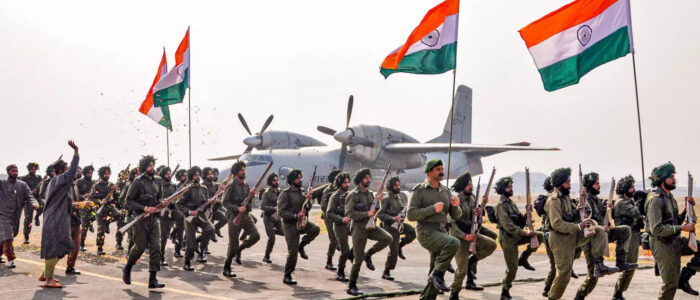Indian Army Faces Challenges of Corruption, Suicide Trends, Groupings, and Moral Issues
During the Kargil conflict of 1999, disputes between the Indian Army and Air Force over armed helicopters caused operational delays and significant casualties.
The Indian Army is divided into two major factions based on geographical regions: Uttarakhand and Nagpur.
New Delhi ( WEB NEWS )
The Indian Army is facing significant challenges such as corruption, rising suicide tendencies among disgruntled personnel, internal groupings, and moral issues, leading to a crisis in its professional capabilities. According to a report by a private TV channel, these issues are casting doubts on the Indian Army’s professional competence, especially in the context of its role in U.S. strategies against China. Historically, India’s military doctrine has been ground-centric, which has neglected joint operational planning. This shortfall was apparent in the wars with China in 1962 and Pakistan in 1965. Initially, the Indian Army relied on Soviet hardware and training, but after the collapse of the Soviet Union, it transitioned to Western systems.
The Indian Army is divided into two major factions based on geographical regions: Uttarakhand and Nagpur. This division creates tensions between the high political and military leadership and military officers. These officers often seek favors, such as promotions to higher ranks, postings to sensitive locations, and welfare benefits. To maintain connections with political leaders, they present gifts at personal events like birthdays and weddings. The groupings among officers further solidify the geographical divisions within the army. The monopoly of graduates from military training institutions, especially Sainik Schools, has led to the formation of cliques and favoritism within the army. High-ranking graduates of Sainik Schools often secure influential postings, promotions, and privileges. This has caused significant dissatisfaction among qualified senior officers who are overlooked due to the prevailing culture of bias. The preference given to Sainik School graduates over other capable individuals raises serious questions about the professionalism and fairness within the Indian Army.
A notable divide exists among senior officers, where those with counter-terrorism (CT) experience, often referred to as “counter-terrorism generals,” are given preference for promotions and high-ranking or sensitive appointments. These generals, primarily serving in the Eastern or Northern Commands to handle counter-terrorism, are favored for their specific experience, though it is believed they lack broader operational and strategic understanding. The current and past appointments of the Chief of Defence Staff (CDS) and Chief of Army Staff (COAS) highlight this trend, suggesting a bias towards counter-terrorism generals.
During the Kargil conflict of 1999, disputes between the Indian Army and Air Force over armed helicopters caused operational delays and significant casualties. Similarly, in 2012, a clash over AH-64D Apache helicopters saw the then IAF Chief fighting to secure ownership and operational control. As part of a response to China, the U.S. reliance on India has pushed the country to enhance its military capabilities. India’s ambitions to become a regional power have led to massive procurement plans, such as the 2005 announcement for 126 Multi-Role Combat Aircraft (MMRCA). Inter-service rivalries, such as the Army’s push for a new Strike Corps without integrating the IAF, have caused bureaucratic hurdles and delays.
The 2010 espionage case involving Indian diplomat Madhuri Gupta highlighted internal conflicts between India’s Intelligence Bureau (IB) and Research and Analysis Wing (R&AW). Gupta’s case exposed not only issues of espionage but also internal wars within India’s intelligence agencies.
Prime Minister Narendra Modi’s influence has significantly impacted the Indian Armed Forces. The new structural reforms aim to address the inefficiencies of the previous 17 single-service commands and align them with successful international models. Modi’s leadership has consistently weakened the effectiveness of internal disputes and political dynamics within the military.

